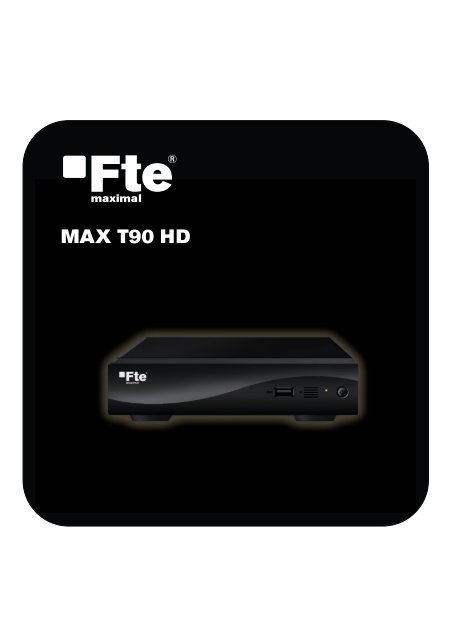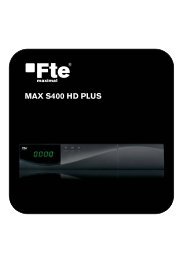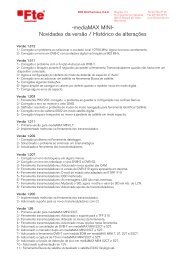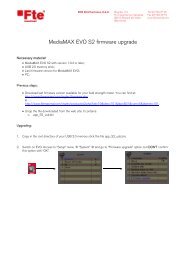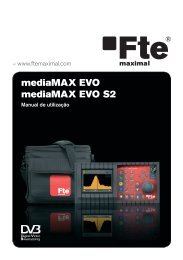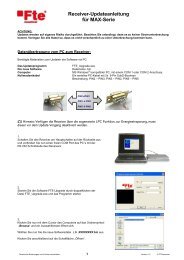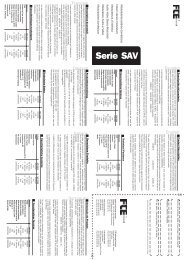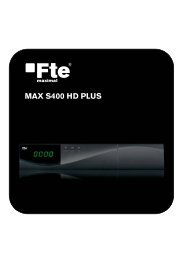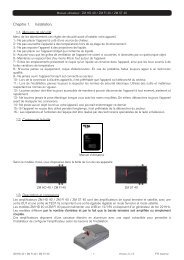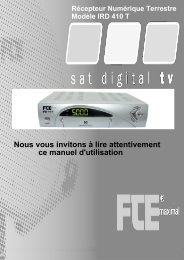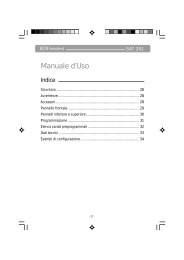MAX T90 HD - FTE Maximal
MAX T90 HD - FTE Maximal
MAX T90 HD - FTE Maximal
Create successful ePaper yourself
Turn your PDF publications into a flip-book with our unique Google optimized e-Paper software.
<strong>MAX</strong> <strong>T90</strong> <strong>HD</strong>
ENGLISH<br />
REMOTE CONTROL<br />
CONTENT<br />
RECEIVER<br />
PAG. 2<br />
BATTERIES X 2<br />
QUICK INSTALLATION GUIDE<br />
rev 1.0
ev 1.0<br />
The lightning fl ash with<br />
arrowhead symbol, within<br />
an equilateral triangle, is<br />
intended to alert the user<br />
to “dangerous voltage”<br />
and to prevent from a<br />
risk of electric shock<br />
QUICK INSTALLATION GUIDE<br />
Warning: To reduce the risk of electric<br />
shock, don’t open the cabinet. Refer<br />
servicing to qualifi ed personnel only.<br />
WARNING: Do not use this STB where contact with or immersion in water is a possibility. Do not use<br />
near fl ower vase, washbowls, kitchen sinks, laundry tubs, swimming pools, etc.<br />
WARNING: Do not put the candle or lamp stand on the cabinet; otherwise, there is the danger of fi re.<br />
WARNING: The unit should be connected to a power supply only of the type described in the operating<br />
instructions or as marked on the unit. If you are not sure of the type of power supply (for example, 120<br />
or 230 V) to your home, consult your local dealer or local power company.<br />
WARNING: This product install diodes. Do not open the cabinet or touch any parts in the inner<br />
mechanism. Consult your local dealer for technical service if the opening is required.<br />
Note: To ensure proper use of this product, please read this User manual carefully and retain for further<br />
reference.<br />
Unit Cleaning: After the unit power is turned off, you can clean the cabinet, panel and remote control<br />
with a soft cloth lightly moistened with a mild detergent solution.<br />
Attachments: Never add any attachments and/or equipment without the manufacturer consent; as such<br />
additions may result in the risk of fi re, electric shock, or other personal injury.<br />
Locating: Slots and openings in the cabinet are provided for ventilation to protect it from overheating.<br />
Do not block these openings or allow them to be blocked by placing the STB on a bed, sofa, or other<br />
similar surface, nor should it be placed over a radiator or heat register.<br />
Power-Cord Protection: Place the power-supply cord out of the way, where it will not be walked on.<br />
Please take special attentions to cords at plugs, convenience receptacles, and the point where they exit<br />
from the unit.<br />
Object and Liquid Entry: Never put objects of any kind into this STB through openings, as they may<br />
touch dangerous voltage points or short-out parts that could result in a fi re or electric shock. Never spill<br />
any liquid on the STB.<br />
Note: Moisture may be formed on the lens In the following conditions:<br />
• when the unit is suddenly moved from a cold environment or an air-condition room to a warm place.<br />
• immediately after a heater has been turned on.<br />
• in a steamy or very humid room.<br />
If the moisture forms inside the unit, it may not operate properly. To correct this problem, turn ok the<br />
power and wait about two hours for the moisture to evaporate.<br />
Parts Replacement: When the unit parts need to be replaced, user should make sure the service<br />
technician use the replacement parts specifi ed by the manufacturer or having the same characteristics<br />
as the original part. Unauthorized replacement may put the unit In the risk of fi re, electric shock or other<br />
hazards.<br />
Safety Check: After all the maintenances and repairs are done, user is required to request the service<br />
technician to conduct the overall safety check to ensure the machine is in the proper condition.<br />
PAG. 3<br />
The exclamation point<br />
within an equilateral<br />
triangle is intended<br />
to alert the user to<br />
important operating and<br />
maintenance (servicing).<br />
ENGLISH
ENGLISH<br />
QUICK INSTALLATION GUIDE<br />
Follow next steps for the correct installation of this receiver.<br />
STEP 1: OUTPUT VIDEO CONFIGURATION<br />
In order to correctly visualise the reception signal on TV, you must confi gure the mode of the video<br />
output. By pressing the [RES] key you can confi gure the output format. Options: (576i / 576p / 720p<br />
/ 1080i / 1080p).<br />
STEP 2: CONNECTIONS<br />
Connect a coaxial cable from the output socket to the “Ant In” connector. Connect a coaxial cable from<br />
the “Loop” connector at the receiver to your TV input connector as it is shown in Scheme1.<br />
This receiver has not built in modulator so it has to be connected to the TV through a <strong>HD</strong>MI or SCART<br />
cable.<br />
EXAMPLE 1<br />
EXAMPLE 3<br />
QUICK INSTALLATION GUIDE<br />
PAG. 4<br />
EXAMPLE 2<br />
rev 1.0
ev 1.0<br />
IMAGE 1<br />
IMAGE 2<br />
QUICK INSTALLATION GUIDE<br />
STEP 3: BASIC CONFIGURATION OF THE<br />
RECEIVER<br />
The receiver includes an installation assistant that will help<br />
you to setup the different parameters.<br />
When the receiver is turned on at fi rst time (using the button<br />
at the rear panel of the receiver), the next menu is shown on<br />
the TV:<br />
In order to move through the different options of this menu,<br />
please use the keysof the remote control. - Region: select<br />
your country using keys.<br />
- OSD Language: select the language of the menu and other<br />
information of the receiver. To choose between the different<br />
languages, use keys of the remote control.<br />
- Output Video Mode: is used to switch the display mode. You<br />
can press [ ] key to select mode output video.<br />
- Aspect Mode is used for switching the screen aspect ratio<br />
mode. Now we provide below options: 4:3 PS / 4:3 LB /<br />
16:9 / AUTO. You can press [ ] key to select each mode<br />
circularly.<br />
- Auto Scan: before making an auto scan (press [OK] button)<br />
be sure that the data of the Region option (Image 1) is<br />
correct, in other case the search of channels will be made<br />
wrongly. Once the Region option is confi rmed, please press<br />
[OK]. ( image 2)<br />
Don’t make any action with the receiver until the Auto scan<br />
has fi nished. For more information about this option, please<br />
read point 4.1 of the complete manual.<br />
PAG. 5<br />
ENGLISH
ENGLISH<br />
CHANNEL<br />
INSTALLATION<br />
SETUP<br />
QUICK INSTALLATION GUIDE<br />
TV Channel List: This option shows the list of TV stored channels.<br />
Radio Channel List: This option shows the list of Radio stored channels.<br />
Delete All Channels: This option deletes all TV and Radio stored channels.<br />
Auto Scan: This option make a full scan of all TV and Radio channels received.<br />
Channel Scan: This option make a compete scan of only one Multiplex.<br />
Tunner Setting: This option allows turns on or off 5V feeding throughcoaxial cable.<br />
LCN: This option can control the channel whether sort by the information in the<br />
streams.<br />
OSD Language: This option allows selecting different menu and options languages.<br />
TV System: This option allows choosing the video Standard and other parameters of the<br />
screen.<br />
Region and Time: In this option, the time of the receiver and user region or country can<br />
be confi gured.<br />
Timer Setting: Timer setting menu.<br />
Parental Lock: In this option, user can lock the access to the menu and change the<br />
password of the receiver.<br />
OSD Setting: In this option, the subtitles of the channel information can be confi gured.<br />
Group Rename: It allows changing the name of the favourite groups.<br />
Auto Standby: In this menu you can confi gure the automatic standby function.<br />
PAG. 6<br />
rev 1.0
ev 1.0<br />
TOOLS<br />
GAMES<br />
QUICK INSTALLATION GUIDE<br />
Information: This option shows all the technical information for the receiver<br />
Load Factory Default: If this option is selected, a reset of the receiver will be done and it<br />
will load the factory default values.<br />
Software Upgrade: To update the receiver by OTA or USB<br />
Remove USB device: Allows remove USB device of safety way.<br />
Othello<br />
Sudoku<br />
MEDIA PLAYER AND RECORDING MANAGEMENT<br />
Media +: Allows reproduce music, image and video<br />
Record Management: Allows to reproduce, to block and to delete recordings<br />
Disk Information: You can see the capacity of the hard disk.<br />
Format <strong>HD</strong>D: Allows to confi gure the hard disk options and to format it.<br />
DVR Confi guration: It allows confi guring the Timeshift activation.<br />
Jump Confi guration: It allows confi guring the jump period that can be used by default in<br />
a recording.<br />
PAG. 7<br />
ENGLISH
ENGLISH<br />
INDEX<br />
1. Remote control & panel description<br />
1.1.Front panel description.................................................................................10<br />
1.2.Rear panel description.................................................................................10<br />
1.3.Remote control description........................................................................11<br />
2. Hotkey<br />
2.1.Standby........................................................................................................12<br />
2.2.PR+/PR-......................................................................................................12<br />
2.3.Vol+/Vol-........................................................................................................12<br />
2.4.Number...........................................................................................................12<br />
2.5.TV/RADIO....................................................................................................12<br />
2.6.Channel list.........................................................................................12<br />
2.7.Audio.............................................................................................................12<br />
2.8.EPG...............................................................................................................12<br />
2.9.Subtitles.......................................................................................................13<br />
2.10.EXIT.............................................................................................................13<br />
2.11.Menu...........................................................................................................13<br />
2.12.Mute............................................................................................................13<br />
2.13.Back..........................................................................................................13<br />
2.14.Information..................................................................................................13<br />
2.15.Teletext..........................................................................................................13<br />
2.16. Favourites.................................................................................................13<br />
2.17. Fast recording.................................................................................................13<br />
2.18. Timeshift.................................................................................................14<br />
2.19. Video Format............................................................................................14<br />
2.20. Media.................................................................................................14<br />
2.21. Usb.................................................................................................14<br />
3. Channel<br />
3.1 TV Channel List.....................................................................................15<br />
3.1.1. Favourite.......................................................................................15<br />
3.1.2. Lock.......................................................................................15<br />
3.1.3. Skip.......................................................................................15<br />
3.1.4. Move.......................................................................................16<br />
3.1.5. Edit channels.......................................................................................16<br />
3.1.5.1. Sort...............................................................................16<br />
3.1.5.2. Rename.........................................................................16<br />
3.1.5.3. Delete...........................................................................16<br />
3.2 Radio channel list..............................................................................17<br />
3.3. Delete all channels..............................................................................17<br />
4. Installation<br />
4.1. Auto scan..............................................................................................18<br />
4.2.Channel scan.....................................................................................18<br />
4.3.Aerial adjustment........................................................................................ 18<br />
4.4.LCN.............................................................................................................19<br />
PAG. 8<br />
rev 1.0
ev 1.0<br />
INDEX<br />
5. System setup<br />
5.1.OSD language....................................................................................20<br />
5.2.TV system................................................................................................20<br />
5.3.Local time settings...............................................................................21<br />
5.4.Timer setting.....................................................................................21<br />
5.5.Parental lock....................................................................................22<br />
5.6.OSD setting..........................................................................................23<br />
5.7.Favorite........................................................................................................23<br />
5.8.Auto Standby........................................................................................................23<br />
6. Tools<br />
6.1.Information.....................................................................................................24<br />
6.2.Load factory default..................................................................................24<br />
6.3.Software upgrade by OTA.........................................................................24<br />
6.4.Software upgrade by USB.........................................................................24<br />
6.5.Remove USB device...........................................................................25<br />
7. Games<br />
7.1.Othello.........................................................................................................26<br />
7.2.Sudoku.........................................................................................................26<br />
8. Rec & Media<br />
8.1.Media Player.........................................................................................27<br />
8.1.1.Adding a new file to the list..............................................................28<br />
8.1.2. Configure the slide show.............................................................28<br />
8.1.3. Audio .MP3 player..........................................................................28<br />
8.1.4. Picture viewer................................................................................28<br />
8.1.5. Sort file....................................................................................29<br />
8.2.Recording management.....................................................................................29<br />
8.2.1.How to reproduce a recording...............................................................29<br />
8.2.2.How to rename a recording..................................................................29<br />
8.2.3.How to block a recording........................................................................29<br />
8.2.4.How to delete a recording.......................................................................30<br />
8.3. <strong>HD</strong>D Information..........................................................................................30<br />
8.4.<strong>HD</strong>D Format.....................................................................................30<br />
8.5.DVR configuration....................................................................................30<br />
8.6. Jump step value.........................................................................................31<br />
9.Technical specification<br />
9.Technical specification......................................................................................32<br />
10.Conformity declaration CE<br />
10.Conformity declaration CE...............................................................................33<br />
PAG. 9<br />
ENGLISH
ENGLISH<br />
REMOTE CONTROL & PANEL DESCRIPTION<br />
1. PANEL & REMOTE CONTROL DESCRIPTION<br />
1.1. FRONT PANEL DESCRIPTION<br />
1. USB: USB Connector 2.0<br />
2.Remote Sensor: Detects the infrared signals from the remote control unit.<br />
3. STAND BY LED: Shows the state of the receiver<br />
4. POWER: Switches the receiver on, or enters standby mode.<br />
1.2. REAR PANEL DESCRIPTION<br />
1 2 3 4 5 6 7<br />
8<br />
1. ANT IN: Input of the digital tuner.<br />
2. LOOP: Ouput for cascading to others devices.<br />
3. COAXIAL S/PDIF: Coaxial output for digital audio (AC3)<br />
4. <strong>HD</strong>MI: <strong>HD</strong>MI output for connecting to a TV<br />
5. TV: Output SCART for the connection to a TV set.<br />
6. VIDEO: Video output for external monitor, TFT or video beamer.<br />
7. AUDIO: Audio output for home audio systems.<br />
8. AC IN: Mains input cable.<br />
PAG. 10<br />
1<br />
2<br />
3<br />
4<br />
rev 1.0
ev 1.0<br />
1<br />
5<br />
8<br />
2 3<br />
6<br />
9<br />
REMOTE CONTROL & PANEL DESCRIPTION<br />
1.3 REMOTE CONTROL DESCRIPTION<br />
4<br />
7<br />
10<br />
11 13 12<br />
14 15<br />
16<br />
18<br />
17<br />
19<br />
20<br />
21 22 23 24<br />
25<br />
29<br />
26 27 28<br />
1. Standby: Switches receiver ON or in stand-by-mode.<br />
2. Info: Shows channel information with signal bar.<br />
3. SUB: Switches subtitle on and off.<br />
4. Mute: Switches audio on and off.<br />
5. |: Forward button for recording and TimeShift.<br />
11. Menú: Opens the main menu.<br />
12. Exit: Exit menus or stop operations.<br />
13. CH+/-: Changes channel up and down.<br />
14. OK: Confi rms selections or opens channel list.<br />
15. Vol+/Vol-: Adjusts audio volume up and down.<br />
16. Record: Quick start for recording.<br />
17. Stop: Stop button for recording and TimeShift.<br />
18. Numeric keys: For direct typing values and names.<br />
19. EPG: Shows the EPG information.<br />
20. Back: Watch the last viewed channel.<br />
21. Media: Opens PVR menu.<br />
22. USB: Opens the multimedia process menu<br />
23. Audio: Opens audio menu.<br />
24. TV/Radio: Switches between TV and Radio channels.<br />
25. TTX: Opens and closes teletext.<br />
26. Timer: Opens the timing menu<br />
27. FAV: Opens favourite channel list.<br />
28. RES: It changes the video output mode in Tv mode.<br />
29. Colour Keys<br />
PAG. 11<br />
ENGLISH
ENGLISH<br />
OSD 1<br />
OSD 2<br />
OSD 3<br />
BASIC OPERATIONS<br />
2. HOTKEY<br />
2.1 STANDBY<br />
1.Press [Power] button to switch from TV mode to Standby<br />
mode<br />
2.In Standby mode press [Power] button again to switch back<br />
to TV mode. The last active channel<br />
will be showed.<br />
3.To switch off the STB complete press the main power<br />
button.<br />
2.2 PR+/PR-<br />
In TV mode press [Channel Up/Channel Down] to change<br />
channel.<br />
2.3 VOL+/VOL-<br />
In TV mode, press [Volume Up/Volume Down] to adjust<br />
volume.<br />
2.4 NUMBER<br />
In TV mode you can enter the channel number directly with<br />
your remote control unit and confi rm the number with the OK<br />
button to change to the desired channel.<br />
2.5 TV/RADIO<br />
In TV mode, press [TV/RADIO] to switch to Radio mode. In<br />
Radio mode press [TV/RADIO] again to switch back to TV<br />
mode.<br />
2.6 CHANNEL LIST<br />
1. In full screen, press [OK/List] key can enter “Channel<br />
List”, please refer to TV Channel List for detail information<br />
(OSD 1).<br />
2.7 AUDIO<br />
1.In TV mode, press the [Audio] button to open the Audio<br />
Mode window. (OSD 2)<br />
2.8 EPG<br />
1.The STB has an Electronic Program Guide (EPG) to help you<br />
navigate channels through all the possible viewing options.<br />
The EPG supplies information such as channel listings and<br />
starting and ending times for all available channels. Press<br />
[EPG] key to display EPG screen. (OSD 3)<br />
2.Press [EXIT] key can play the current channel in full<br />
screen.<br />
3.Press number key [OK] can display the current channel<br />
detail information. The window is like below.<br />
4.We should press green button if we wish to program a timing<br />
of the selected event. The timing window will be opened<br />
automatically and this way we will be able to confi rm the<br />
programming of the event. We should press Exit if we wish<br />
PAG. 12<br />
rev 1.0
ev 1.0<br />
OSD 4<br />
OSD 5<br />
OSD 6<br />
OSD 7<br />
BASIC OPERATIONS<br />
to come back to channel list.<br />
5.With the key [Red], you will get new options that will allow<br />
you to move through the EPG on the most comfortable way,<br />
moving event by event, by sites or by days.<br />
6.To close the EPG menu press [Exit].<br />
2.9. SUBTITLES<br />
In TV mode, press [Subtitle] button for activating / deactivating<br />
the channel subtitles, depending on the provider information<br />
(OSD 4).<br />
2.10 EXIT<br />
[Exit] key can exit current menu.<br />
2.11 MENU<br />
[Menu] key can enter the menu or exit current menu.<br />
2.12 MUTE<br />
1.Press the [Mute] button to mute the sound. On the screen<br />
an icon will be displayed to indicate the muted sound.<br />
2.Press the [Mute] button again to restore the sound.<br />
2.13 BACK<br />
Pressing the [BACK] button allows you to toggle between the<br />
actual and the last selected channel.<br />
2.14 INFORMATION<br />
In TV mode, press [INFO] button can open information screen<br />
(OSD 5).<br />
2.15 TELETEXT<br />
1.Press [TXT] button in TV mode to open the teletext page.<br />
This service is depending on the support of the channel<br />
provider.<br />
2.If the channel does not support teletext information, it will<br />
show “No Teletext Data” on the screen.<br />
2.16 FAVOURITES<br />
1. In TV mode press the [Favourite] button to display the<br />
Favourite Group window on the screen as the picture beside<br />
shows (OSD 6).<br />
2. In the Favourite Group window you can select the desired<br />
favourite channel with [ ] and confi rm it with [OK] to<br />
switch to it.<br />
3. Press [Exit] to close the Favourite Group window.<br />
2.17. FAST RECORDING<br />
To start the recording (OSD 7).<br />
1. If you would like to record a programme immediately, press<br />
the Key [Record]. In order to stop a recording before the<br />
ending of the programmed length, press the [Stop]-Key.<br />
2. A new window will be shown in order to confi rm the end<br />
PAG. 13<br />
ENGLISH
ENGLISH<br />
OSD 8<br />
BASIC OPERATIONS<br />
of the recording. If you press the Key [Exit], the recording will<br />
continue.<br />
3.Press the key [Stop] again to end the recording manually,<br />
if you want to end the recording before the programmed<br />
length.<br />
2.18. TIMESHIFT<br />
In order to activate this Timeshif option, please access to DVR<br />
confi guration menu.<br />
From the moment the user access to the channel, the receiver<br />
keeps all the channel information in a buffer (OSD 8).<br />
All the information is on the hard disk, for this reason it is<br />
possible to play, pause, fast forward and reward.<br />
1. Pressing the button [] several times, you can<br />
settle the speed of forward. Options: 2x, 4x, 8x, 16x or 24x.<br />
2. Using the key [Info] you can see the time difference<br />
between your reproduction and the real time.<br />
3. In order to leave the Time Shift option, press the key [stop]<br />
to equal the difference between the reproduction time with<br />
the real one.<br />
2.19. VIDEO FORMAT<br />
In Tv mode, press [RES] key in order to confi gure the output<br />
format of your receiver.<br />
2.20. MEDIA<br />
It opens directly the recording administration menu.<br />
2.21. USB<br />
It opens directly the <strong>HD</strong>D administration menu<br />
PAG. 14<br />
rev 1.0
ev 1.0<br />
OSD 9<br />
OSD 10<br />
OSD 11<br />
OSD 12<br />
OSD 13<br />
CHANNEL<br />
PAG. 15<br />
3.CHANNEL<br />
Press [Menu] in the TV mode to enter the main menu (OSD<br />
9).<br />
1. Press [ ] to select the Channel item.<br />
2. Press [OK] to enter the selected item.<br />
In the Channel menu (OSD 10):<br />
3. Press [ ] to select the wanted menu item.<br />
4. Press [OK] to enter the selected item among.<br />
- TV Channel List<br />
- Radio Channel List<br />
- Delete all channels<br />
3.1 TV CHANNEL LIST<br />
When you enter to “Channel List” menu, there will display the<br />
screen like below (OSD 11).<br />
1.You can move highlight by press [ ] key to preview<br />
the current highlighted program in the right side preview<br />
window.<br />
2.You can use [ ] key to switch “Group”.<br />
3.Press the number key [FAV, [Red], [Green], [Yellow]<br />
and [Blue]can implement the corresponding function in<br />
“Channel List”.<br />
3.1.1 FAVOURITE<br />
1. Press [FAV] and [OK] to open the Favourite window.<br />
2. You can move highlight between 8 favorite groups by press<br />
[ ] key and press [OK] key.<br />
3. Once the favourites group has been selected press EXIT in<br />
order to get out of this option.<br />
4. There will show a favorite mark beside the marked channel<br />
(OSD 12).<br />
3.1.2 LOCK<br />
1. In “TV Channel List Edit” menu, press number key [Red].<br />
2. Next press [OK] over the channel you wish to block. A<br />
window will appear, please insert password in it in order<br />
to get the channel blocked. Once the password has been<br />
correctly inserted, a mark will appear on the right side of<br />
the channel’s name (OSD 13).<br />
3.1.3 SKIP<br />
In “TV Channel List Edit” menu, press number key [Green]<br />
can make a “skip mark” in the right side of the highlighted<br />
channel. After save and exit “TV Channel List Edit” menu,<br />
ENGLISH
ENGLISH<br />
OSD 14<br />
OSD 15<br />
OSD 16<br />
OSD 17<br />
OSD 18<br />
CHANNEL<br />
the channel will be skip while user change channel in the full<br />
screen. (OSD 14).<br />
3.1.4 MOVE<br />
1. Press number key[Yellow], next press [OK] over the channel<br />
you wish to move and a movement symbol will appear in the<br />
right side of the selected channel like above (OSD 15)<br />
2. You can move the selected channel to the position that you<br />
want to place by press [ ] key. And press [OK] key to<br />
confi rm your decision.<br />
3.1.5 TV CHANNEL LIST EDIT<br />
1. Press [Blue] button to open the “Edit” window.<br />
2. You can Delete, Sort, and Edit the channel (OSD 16).<br />
3. Press [Exit] to leave the Channel Editing. The system will<br />
ask you to confi rm the saving of the changes you made.<br />
3.1.5.1 SORT<br />
1. Press number key [Red] can open the “Sort” window like<br />
above (OSD 17). There are fi ve kinds of sorting ways. You<br />
can press [ ] key to move highlight and press [OK]<br />
key to confi rm you selection<br />
2. The fi ve kinds of sorting way are:<br />
•Default: Sorting by scanning result.<br />
•Name (A-Z): Sorting in Alphabetical Order, ignore symbol.<br />
•Name (Z-A): Sorting in Alphabetical Order, ignore symbol.<br />
•Lock: Accumulated all locked channels and list in the<br />
beginning of TV Channel List<br />
•Free/Coded: It shows the coded channels at the end of the<br />
list.<br />
3.1.5.2 RENAME<br />
1. In “TV Channel List Edit” menu, press number key [Green]<br />
can enter edit box like below (OSD 18):<br />
2. After modifi cation, press [Blue] key can save the modifi ed<br />
value and exit “Edit” mode. Otherwise, press [Exit] key can<br />
exit “Edit” mode and won’t save any modifi cation.<br />
3.1.5.3 DELETE<br />
In “TV Channel List Edit” menu, press number key [Blue], the<br />
channel will be deleted. Next press [OK] over the channel you<br />
wish to remove (OSD 19).<br />
PAG. 16<br />
rev 1.0
ev 1.0<br />
OSD 19<br />
OSD 20<br />
OSD 21<br />
CHANNEL<br />
3.2 RADIO CHANNEL LIST<br />
Basically, the operation of “Radio Channel List” is same as<br />
“TV Channel List”, but there is one point different: In “Radio<br />
Channel List” mode, there is no video information, so it will<br />
always display Radio’s logo in the right side preview window.<br />
(OSD 20)<br />
3.3.DELETE ALL CHANNELS<br />
For removing all channel list, press the button [OK] (OSD<br />
21).<br />
1. There will show up a warning message box to inquire you<br />
whether delete all or not.<br />
2. If you select “Yes”, all channels will be deleted.<br />
3. In step 1 and step 2, press [Exit] key can exit the function<br />
directly without save.<br />
PAG. 17<br />
ENGLISH
ENGLISH<br />
OSD 22<br />
OSD 23<br />
OSD 24<br />
OSD 25<br />
INSTALLATION<br />
PAG. 18<br />
4.INSTALLATION<br />
Press [Menu] in the TV mode to enter the main menu (OSD<br />
22).<br />
1. Press [ ] to select the Installation item.<br />
2. Press [OK] to enter the selected item.<br />
In the Installation menu (OSD 23):<br />
3. Press [ ] to select the wanted menu item.<br />
4. Press [OK] to enter the selected item among.<br />
- Auto Scan<br />
- Channel Scan<br />
- Aerial adjustment<br />
- LCN<br />
4.1.AUTO SCAN<br />
When you enter to “Auto Scan” menu, there will display the<br />
screen like below (OSD 24):<br />
1. Firstly please select the country in System Setup Menu /<br />
Local Time Settings / Region<br />
2. In “FTA Only” item, press [ ] key to select scans all<br />
channels or just scans free channels.<br />
3. Moving the highlight to “Search” item and press [OK] key to<br />
start scanning. 4 In the “Auto Scan” menu, press [Exit] key<br />
to draw back from the scanning.<br />
4.2 CHANNEL SCAN<br />
When you enter to “Channel Scan” menu, there will display<br />
the screen like below (OSD 25):<br />
1. There is two mode. You can scan channel by channel or<br />
by frequency” .<br />
2. When scan band is UHF, the range of Ch No. is from 21<br />
to 69.<br />
3. When you complete your modifi cation,move highlight to<br />
“Search” item and press [OK] key, then it will begin to<br />
scan.<br />
4. In the “Channel Scan” item, press [Exit] key to exit the<br />
scanning and save the current parameters.<br />
4.3 AERIAL ADJUSTMENT<br />
1. When you enter to “Tuner setting” menu, there will display<br />
the screen like below (OSD 26): In Aerial Adjustment<br />
mode:<br />
Tuner Power: On / Off.<br />
2. Select a channel with signal to verify that reception is<br />
correct to turn on the supply of 5Vdc.<br />
rev 1.0
ev 1.0<br />
OSD 26<br />
OSD 27<br />
INSTALLATION<br />
4.4 LCN<br />
This option makes an automatic ordering of the channels after<br />
a search. Before activating this option please verify that the<br />
function LCN (Logical channel number) is available in your<br />
region (OSD 27).<br />
PAG. 19<br />
ENGLISH
ENGLISH<br />
OSD 28<br />
OSD 29<br />
OSD 30<br />
SYSTEM SETUP<br />
PAG. 20<br />
5. SYSTEM SETUP<br />
Press [Menu] in the TV mode to enter the main menu .<br />
1. Press [ ] to select the System Setup item.<br />
2. Press [OK] to enter the selected item.<br />
In the System Setup menu (OSD 28):<br />
3. Press [ ] to select the wanted menu item.<br />
4. Press [OK] to enter the selected item among (OSD 29).<br />
- OSD Language<br />
- TV System<br />
- Local Time Setting<br />
- Timer Setting<br />
- Parental Lock<br />
- OSD setting<br />
- Favorite<br />
- Auto Standby<br />
5.1 OSD LANGUAGE<br />
When you enter to “Language” menu, you will see the screen<br />
like below (OSD 30):<br />
1.OSD Language: press [ ] key to select languages, the<br />
selections of languages include: English, French, German,<br />
Italian, Spanish, Portuguese, Polish, Greek, Russian,<br />
Slovenian and Croatian.<br />
2. First Audio: Some channels offer more than one audio<br />
language. This function allows you to set the preferred audio<br />
language for those channels using [ ]. If a channel offers<br />
the same audio language as the “First Audio” you set the<br />
system will play this audio language as default. If the channel<br />
does not offer this audio language then the system will compare<br />
the offered languages with the second audio language.<br />
3. Second Audio: If the channel has no audio language that<br />
corresponds with “First Audio” but with “Second Audio” the<br />
system will play the second audio language as default. If no<br />
audio language corresponds with the “Second Audio” then<br />
the default language of the current channel will be played<br />
instead.<br />
4. Subtitles language: You can choose the predetermined<br />
subtitles language by using [ ] keys.<br />
5. Teletext: You can choose the predetermined language of<br />
the teletex using the keys [ ].<br />
6. Press [Exit] to return back from “Language” menu.<br />
5.2 TV SYSTEM<br />
When you enter to “TV System” menu, you will see the screen<br />
like below (OSD 31):<br />
1. Display Mode is used to switch the display mode. You can<br />
rev 1.0
ev 1.0<br />
OSD 31<br />
OSD 32<br />
OSD 33<br />
OSD 34<br />
SYSTEM SETUP<br />
select from 576i / 576p / 720p / 1080i/ 1080p in <strong>HD</strong>MI<br />
mode and 576i in RGB mode. Press [ ] to select the<br />
desired mode.<br />
2. Aspect Mode is used for switching the screen aspect ratio<br />
mode. Now we provide below options: 4:3 PS / 4:3 LB /<br />
16:9 / AUTO. You can press [ ] key to select each mode<br />
circularly.<br />
3. In video output you can choose, by the means of [ ] keys,<br />
the video output mode: RGB / <strong>HD</strong>MI. We recommend<br />
selecting YUV mode when the connection is made by<br />
<strong>HD</strong>MI, if on the contrary it is made by scart cable, we<br />
recommend selecting RGB mode.<br />
4. Digital Audio Out: It will allow you to select the type of<br />
audio digital output. Options: LPCM Out / BitStream Out.<br />
If you connect this output to a device with Dolby digital,<br />
select BitStream Out option.<br />
5. Press [Exit] key to draw back from “TV System” menu.<br />
5.3 LOCAL TIME SETTINGS<br />
When you enter to “Local Time Setting” menu, you will see<br />
window like below (OSD 32):<br />
1. Region is used for selecting the country which you are in.<br />
You can press [ ] key to select each mode circularly.<br />
2. GMT Usage: This item is use for open the usage of GMT.<br />
You can press [ t] keys to switch “Off / On”.<br />
3. The “GMT Offset” item is valid only when the setting of<br />
“GMT Usage” is “Off”. You can press [ ] keys to switch<br />
“GMT Offset” value, and the range is “-12:00 ~ +12:00”,<br />
increase each half hour progressively.<br />
4. Summer Time: this option is only available when “GMT<br />
Usage” is enabled. Use [ ] to switch On/Off the summer<br />
timetable.<br />
5. “Date” and “Time” items are valid only when the setting of<br />
“GMT Usage” is “Off”. You can press [ ] keys to moving<br />
highlight and use number keys to input directly.<br />
6. Press [Exit] key to return back from ”TV System” menu.<br />
5.4 TIMER SETTING<br />
When you enter “Timer Setting”, you will see the window like<br />
OSD 33. You can press [ ] keys to set Timer number,<br />
and there are 8 timers in total. When you press [OK] key you<br />
will see a screen like beside (OSD 34):<br />
1. Current time information will display on the fi rst column;<br />
if the current time is incorrect, please modify the time<br />
information in “Time” item.<br />
2. Timer Mode: There are several modes for Timer to setting,<br />
include Off, Once, Daily.<br />
3. Timer Type: You can choose between “DVR Recorder”/<br />
PAG. 21<br />
ENGLISH
ENGLISH<br />
OSD 35<br />
SYSTEM SETUP<br />
“Radio Recorder” (so you can program a recording of a TV<br />
or a Radio channel), “Reproduce Channel” / “Reproduce<br />
Radio” (that way, you will assign the alarm function to a<br />
concrete TV or Radio channel)<br />
4. Wake up Channel: press [OK] key to enter channel list and<br />
select channel that you want to setting.<br />
5. Wake up Date: use number keys to input your wakeup<br />
date.<br />
6. Wake up Time: use number keys to input your wakeup time.<br />
Once the time’s up, no matter what the system is in standby<br />
mode or in playing mode, the system will automatically<br />
switch to the channel you want and start to play.<br />
7. Duration: Please introduce the duration of the timing.<br />
8. Press [Exit] can exit the current menu.<br />
5.5 PARENTAL LOCK<br />
You can set a password for anyone who wishes to operate in<br />
the “Installation” menu. And you can also set the password<br />
for the lock channels. (How to set the lock channel please<br />
refer to LOCK) Here will show you how to setting and how to<br />
revising the password.<br />
In “Parental Lock” function, press [OK] key, there will pop an<br />
dialogue for you to input the password. The default password<br />
is “0000”. When you input the correct password, you will see<br />
a screen like below(OSD 35):<br />
1.Menu Lock determining that when user wish to enter<br />
“Installation” menu, whether have to input Password or not.<br />
If the setting of “Menu Lock” is “Yes” which means user<br />
have to key in password, set “No” means unlock.<br />
2. Channel Lock determining that when user wish to play the<br />
lock channels, whether have to input the password or not.<br />
If the setting is “Yes”, play the channels with lock mark will<br />
show up a dialogue on the screen and ask for the password.<br />
If the setting of “Channel Lock ”is “No”, the Lock function<br />
will invalid.<br />
3. New Password is used for revising password; you can input<br />
the new password in this item by using number keys directly.<br />
After you fi lled in 4 digital numbers, the highlight will auto<br />
skip to Confi rm Password and ask you to input the new<br />
password again. If the password is correct, the screen will<br />
show up a message of “Change password successfully”.<br />
After fi nish saving and draw back to “System Setup” menu,<br />
the revising is complete.<br />
4.Press [Exit] key to draw back from the “Parental Lock”<br />
menu.<br />
PAG. 22<br />
rev 1.0
ev 1.0<br />
OSD 36<br />
OSD 37<br />
OSD 38<br />
SYSTEM SETUP<br />
5.6. OSD SETTING<br />
When you input to “OSD Setting” menu, you will see a screen<br />
like below (OSD 36):<br />
1. OSD Timeout: If you confi gure this option you will be able<br />
to change OSD time of information of the channel that is<br />
tuned in every moment.<br />
2. OSD Transparency: Besides the setting of “OSD Menu<br />
Style”, you also can set the transparency of OSD. You can<br />
press [Left/Right] key to select the values. There are 5<br />
levels of transparency, 10%, 20%, 30%, and 40% and<br />
“NO” (means no transparency function).<br />
3. Load Default OSD Setting: If you are not satisfy with your<br />
setting, you can move highlight to this item and press [OK]<br />
key to reset parameters as default value.<br />
4. Press [Exit] key to draw back from the “OSD Setting”<br />
menu.<br />
5.7. FAVORITE<br />
In this menu, user is able to change the name of the Favourite<br />
Groups. Press [OK] to enter this menu and you will see a<br />
screen like beside (OSD 37).<br />
To change the name of the Favourites Groups:<br />
1. Press [ ] and select a Favorite Group.<br />
2. Press [Ok] button to edit the name of the Group.<br />
3. Once the name is correct, confi rm pressing [Blue] button.<br />
4. Select “Exit” to leave this menu.<br />
5.8. AUTO STANDBY<br />
Auto Standby: This option will allow you to activate or<br />
deactivate the automatic Standby option (OSD 38). Options:<br />
On, Off.<br />
-On: The receiver will be in standby mode automatically after<br />
3 hours, as long as during this time no commands have been<br />
sent to the receiver through the remote control or buttons of<br />
the front panel, and no programmed timers are run.<br />
-Off: Auto standby function gets deactivated.<br />
PAG. 23<br />
ENGLISH
ENGLISH<br />
OSD 39<br />
OSD 40<br />
OSD 41<br />
OSD 42<br />
TOOLS<br />
PAG. 24<br />
6.TOOLS<br />
Press [Menu] in the TV mode to enter the main menu (OSD<br />
39).<br />
1. Press [ ] to select the Tools item.<br />
2. Press [OK] to enter the selected item.<br />
In the Tools menu (OSD 40):<br />
3. Press [ ] to select the wanted menu item.<br />
4. Press [OK] to enter the selected item among.<br />
- Information<br />
- Load Factory Default<br />
- Software Upgrade by OTA<br />
- Software Upgrade by USB<br />
- Safely Remove Storage Device<br />
6.1 INFORMATION<br />
1. When you enter to “Information” menu, you will see a<br />
screen like above (OSD 41). The screen displays some<br />
parameters of information of current channel, and this<br />
function same as the function [Information] in the full<br />
screen play mode.<br />
2. Press [Exit] key to draw back from “Tools” menu.<br />
6.2 LOAD FACTORY DEFAULT<br />
When you press [OK] on the “Factory Setting” item:<br />
1. A warning message will be displayed like the one beside<br />
(OSD 42).<br />
2. If you select “Yes” then all changes you made will be reset<br />
to default values. Make sure you really want to do this!<br />
3. Press [Exit] in both steps will close the window without<br />
resetting the receiver.<br />
6.3 SOFTWARE UPGRADE BY OTA<br />
This option allows updating the software of the receiver<br />
through the data received by OTA.<br />
1. Please select the multiplex or introduce directly the values<br />
for the updating.<br />
2. Please select “Start” and press [OK] for starting the<br />
software updating (OSD 43).<br />
6.4 SOFTWARE UPGRADE BY USB<br />
This option allows updating the software of the receiver with<br />
the received data from a USB 2.0 memory device. To do<br />
it, connect a USB 2.0 memory device to the receiver and<br />
accede to this menu option (OSD 44).<br />
The last software version to be loaded must be placed at the<br />
root path of your USB device.<br />
rev 1.0
ev 1.0<br />
OSD 43<br />
OSD 44<br />
OSD 45<br />
TOOLS<br />
1. Upgrade mode: Select with [ ] , the mode of upgrading.<br />
2. Update fi le: Select with [ ] the name of the fi le to be<br />
loaded.<br />
3. Select “Start” and press [OK]. An alert message appears<br />
indicating not to take out the memory device during the<br />
loadiing process.<br />
4. Once the fi le has been loaded, it requires the conformity<br />
to end the upgrading process, writing into the receiver<br />
the upgrading. Select “Yes” and press [OK] to upgrade<br />
the receiver. In case during the reading of the fi le, it is<br />
corrupted or it would be a not appropriated for this model<br />
of receiver, an alert messagewould appear “Error reading<br />
the USB disk”.<br />
5. After pressing [OK] the receiver will write into the Flash<br />
memory, and it will reboot to end the upgrading process.<br />
For further information about the upgrading of the receivers,<br />
please visit http://www.ftemaximal.com, in the chapter about<br />
upgrading receivers.<br />
6.5 SAFELY REMOVE STORAGE DEVICE<br />
In “Tools” menu, select “Safely Remove Storage Device”,<br />
press “OK”, to disconnect USB device of receiver (OSD 45).<br />
PAG. 25<br />
ENGLISH
ENGLISH<br />
OSD 46<br />
OSD 47<br />
OSD 48<br />
GAMES<br />
PAG. 26<br />
7.GAMES<br />
When you enter “Game” menu (OSD 46), you will see three<br />
games including Othello and Sudoku.<br />
7.1 OTHELLO<br />
1. Moving highlight to “Setup” and press [Left/Right] keys to<br />
select the game level (degree of diffi culty) (OSD 47).<br />
2. Moving highlight to “Start” and press [OK] key to start the<br />
game.<br />
3. Moving highlight to [Exit] keys and press [OK] key to draw<br />
back from the game.<br />
4. Start on the game:<br />
• [ /[ ] use these arrow keys to guide chessman.<br />
• [OK] — set chessman.<br />
• [Exit] — Quit game and draw back to “Game” menu.<br />
7.2 SUDOKU<br />
1. Moving highlight to “Setup” and press [Left/Right] keys to<br />
select the game level (degree of diffi culty) (OSD 48).<br />
2. Moving highlight to “Start” and press [OK] key to start the<br />
game.<br />
3. Select the option “Replay” and press [OK] in order to start<br />
again the same game.<br />
4. Select the option “Solve” and press [OK] in order to see the<br />
solution of the game.<br />
5. Moving highlight to [Exit] keys and press [OK] key to draw<br />
back from the game.<br />
6. Use the keys , , to guide the pointer.<br />
7. Use the numeric keypad in order to add a number in every<br />
square.<br />
8. [Exit] — Quit game and draw back to “Game” menu.<br />
rev 1.0
ev 1.0<br />
Recorded fi les<br />
Options<br />
OSD 49<br />
OSD 50<br />
REC & MEDIA<br />
PAG. 27<br />
8. REC & MEDIA<br />
Press the key [Menu] on the remote control to go to the main<br />
menu (OSD 49).<br />
1. Press the arrows on the remote control [ ] to select<br />
the option REC & MEDIA.<br />
2. Press [Ok] to enter the submenu REC & MEDIA.<br />
3. Press the keys on the remote control[ ] to move to<br />
the different options on the menu (OSD 50)<br />
4. Press [Ok] to go to the selected option on the submenu.<br />
- Media Player<br />
- Record Manager<br />
- Disk Information<br />
- <strong>HD</strong>D Format<br />
- DVR Confi guration<br />
- Jump<br />
8.1. MEDIA PLAYER<br />
In this menu option you can accede and manage the contents<br />
of the <strong>HD</strong>D previously copied from your computer.<br />
You also can create playlists of music or pictures (OSD 51).<br />
Press [Menu] button to Exit.<br />
OSD 51<br />
Preview window of<br />
the selected fi le<br />
Information about<br />
the selected fi le.<br />
- PLAYLIST<br />
These lists are created adding the fi les you want to the<br />
previous lists. You can create 2 lists:<br />
- Picture List<br />
- Music List<br />
ENGLISH
ENGLISH<br />
OSD 52<br />
OSD 53<br />
OSD 54<br />
OSD 55<br />
REC & MEDIA<br />
In order to open the play list, please press [yellow button] and<br />
select which of the two list you wish to open (OSD 52).<br />
1. Press [Red button] on any fi le from one list to play all the<br />
fi les contained.<br />
2. Press [Yellow button] on any fi le from one list to delete<br />
the fi le.<br />
3. Press [Blue button] on any fi le from one list to delete all the<br />
fi les contained.<br />
4. Press the keys [ ] to move along the fi les and press<br />
[OK] to enter and exit of the folders or open a fi le or<br />
playlist.<br />
8.1.1.ADDING A NEW FILE TO THE LIST<br />
1. Go over the fi le you want to add to your customized playlist<br />
and press the [FAV] button.<br />
2. In order to add all the music fi les to the music play list,<br />
please press [0].<br />
3. In order to add all the images to the images play list, press<br />
[1].<br />
8.1.2.CONFIGURE THE SLIDE SHOW<br />
*Only available for the picture playlist (OSD 53).<br />
This function allows you to confi gure the “slide show”,<br />
therefore,<br />
1. Select setup option, press [INFO].<br />
2. A new window will appear where you should confi gure<br />
some parameters:<br />
- Time of viewing each picture on the screen.<br />
- Repeat: When the playlist fi nishes, it starts again.<br />
8.1.3.AUDIO .MP3 PLAYER<br />
1. Press [OK] over the.MP3 fi le or list of .MP3 fi les you want<br />
to play (OSD 54).<br />
2. A Player will be opened as it is shown in the picture.<br />
-[Blue]: It changes among the different ways of replay:<br />
random, list or single.<br />
8.1.4.PICTURE VIEWER<br />
1. Press [OK] over the fi le .JPG that you want to show.<br />
2. The selected image will be shown in the screen and the<br />
reproduction of the images will start in slide show way.<br />
3. You can rotate the picture with the buttons [ ]. (OSD<br />
55)<br />
PAG. 28<br />
rev 1.0
ev 1.0<br />
OSD 56<br />
OSD 57<br />
OSD 58<br />
OSD 59<br />
OSD 60<br />
REC & MEDIA<br />
8.1.5. SORT FILE<br />
1. Press the [red] key to open the Sort window (OSD 56).<br />
Press [ ] to select and [OK] to confi rm your choice.<br />
2. The ways of sorting are:<br />
- Default: Sorting by scanning result.<br />
- Name (A-Z): Sorting in Alphabetical Order, ignoring “$”<br />
symbol.<br />
- Name (Z-A): Sorting in Alphabetical Order, ignoring “$”<br />
symbol.<br />
- 1º Image: Sort imagen fi les in fi rst position.<br />
- 1º Music: Sort music fi les in fi rst position.<br />
8.2. RECORD MANAGEMENT<br />
With this option of the menu, you can reproduce, rename,<br />
block and delete recordings (OSD 57).<br />
8.2.1. HOW TO REPRODUCE A RECORDING<br />
If you want to reproduce a recording, you only have to select<br />
it and press the key [OK] (OSD 58).<br />
8.2.2. HOW TO RENAME A RECORDING<br />
1. Press the key [Red] to rename a recording.<br />
2. A window will appear where you can change the name<br />
of the record (OSD 59). Press OK [Blue] to go out and<br />
modify the name.<br />
3. Press the [Exit] key to leave. A window will ask for<br />
confi rmation to save the changes.<br />
8.2.3. HOW TO BLOCK A RECORDING<br />
With this function it is possible to block a recording so it is<br />
necessary to introduce a password to watch it.<br />
1. If you want to block a recording, select it and press the<br />
[Green] key.<br />
2. A window appears and asks for the password. If it has not<br />
been modifi ed, it is by default the code “0000”.<br />
3. The blocked channel is marked with an icon (OSD 60).<br />
4. In order that the blockade of channels work, it is necessary<br />
that the blocking option is activated in the menu of<br />
“Blockade with password”.<br />
5. Press the key [Exit] to leave.<br />
PAG. 29<br />
ENGLISH
ENGLISH<br />
OSD 61<br />
OSD 62<br />
OSD 63<br />
OSD 64<br />
REC & MEDIA<br />
8.2.4. HOW TO DELETE A RECORDING<br />
1. To delete one or more recordings, press the [Blue] key<br />
on the recording you want to delete (if you want to delete<br />
several recordings, select them one by one).<br />
2. A mark will appear on the name of the channel (OSD 61).<br />
3. The marked recordings will be deleted once you exit the<br />
menu.<br />
8.3. DISK INFORMATION<br />
In the <strong>HD</strong>D information submenu you can see the capacity<br />
of the hard disk. You also see the free space available (OSD<br />
62).<br />
8.4. <strong>HD</strong>D FORMAT<br />
This option will format the hard disk, deleting it completely<br />
(OSD 63)<br />
1. In the option “Storage Partition”, please select through the<br />
keys [ ] the hard disk partition you want to format.<br />
2. Please place the cursor over “Format” and press [OK].<br />
3. A new window will appear, where you will have to choose<br />
the kind of format that you want to assign to the partition<br />
(OSD 64). Options: FAT or NTFS . Press [OK] over one of<br />
the options. The hard disk will be formatted and it will lose all<br />
the recordings in the memory.<br />
NOTE: There is no turning back for this process. After the<br />
selection of one of these options, the data will be deleted.<br />
4. Press [Exit] in order to go out without formatting.<br />
8.5. DVR CONFIGURATION<br />
In this menu you will be able to confi gure the Timeshift<br />
activation and the recording format (OSD 65).<br />
1. You can confi gure the Timeshift in two ways:<br />
On: From the moment the user access to the channel, the<br />
receiver keeps all the channel information in a buffer.<br />
Off: the receiver will no store any channel information. If the<br />
users makes a Pause the image will stop, but when he<br />
wants to continue watching the program it will be running in<br />
the current moment.<br />
2. In the “Timeshift recording” option we can select between<br />
two options:<br />
-On: It allows the running of the Timeshift while recording a<br />
channel.<br />
- Off: The Timeshift option gets disabled while recording.<br />
3. In the “recording type” option you can select between PS<br />
and TS format.<br />
PAG. 30<br />
rev 1.0
ev 1.0<br />
OSD 65<br />
OSD 66<br />
REC & MEDIA<br />
4. In the “partition selection” option you can choose which<br />
of the disk partition you want to use for making the<br />
recordings.<br />
5. The “Standby after recording” option allows the receiver to<br />
switch to Standby mode once the Programmed Recording<br />
is fi nished.<br />
8.6. JUMP STEP VALUE<br />
With this option you can settle the jump marks forward and<br />
reward (OSD 66).<br />
On a current reproduction, press the keys [||] to<br />
make a jump of a certain period of time on the reproduction.<br />
This period is confi gurable and the jumps can be: 30s, 1, 5,<br />
10 and 30 minutes.<br />
If they are confi gured every 10 minutes, each time that you<br />
press this key, it will jump automatically 10 minutes forward/<br />
reward on the reproduction.<br />
PAG. 31<br />
ENGLISH
ENGLISH<br />
Video<br />
Decoding<br />
Output<br />
Aspect ratio<br />
Active pixel (Scart)<br />
Active pixel (<strong>HD</strong>MI)<br />
Output connector<br />
Audio<br />
Decoding<br />
Output connector<br />
Demodulator<br />
Standard<br />
Demodulation<br />
Guard Interval<br />
FEC<br />
Input Signal<br />
Frequency<br />
Imput Level<br />
Band width<br />
Rf Input connector<br />
RF Loopthrough Connector<br />
Miscellanous<br />
USB Connector<br />
Media formats (*available with hard disk<br />
connected to USB 2.0 port)<br />
Supply voltage<br />
Power consumption<br />
Standby consumption (LPC Mode)<br />
Operation temperature<br />
Dimension (W x D x H)<br />
Weight<br />
TECHNICAL SPECIFICATIONS<br />
MPEG4 AVC/H.264 HP@L4, MPEG-2<br />
PAL<br />
4:3 PS, 4:3 LB, 16:9, Auto<br />
576i<br />
576i / 576p / 720p / 1080i / 1080p<br />
<strong>HD</strong>MI / Scart / RCA<br />
AAC/AC3/PCMII/Dolby Digital +<br />
<strong>HD</strong>MI / Scart/ Coaxial SPDIF / RCA<br />
DVB-T<br />
COFDM (QPSK / 16 QAM / 64 QAM) 2k, 8k<br />
1/4, 1/8, 1/16, 1/32<br />
1/2, 2/3, 3/4 , 5/6, 7/8<br />
47 - 862MHz<br />
-73dBm - 20dBm<br />
6 MHz / 7 MHz / 8 MHz<br />
IEC Female<br />
IEC Male<br />
2.0<br />
Image: .JPG, .BMP / Audio: .MP3, .OGG,.WAV<br />
Record: .TS / PS<br />
Video: .MPG(MPEG2 MP@HL )<br />
.AVI (MPEG1/ MPEG2 MP@HL/H.264 HP@L4.1/<br />
Dvix / Xvid)<br />
.MKV (MPEG1/MPEG2 MP@HL/H.264 HP@L4.1/<br />
Dvix)<br />
.MP4 (MPEG1/MPEG2 MP@HL/H.264 HP@L4.1/<br />
.MOV (H.264 HP@L4.1 / MPG2 Video)<br />
220~240VAC 50~60 Hz<br />
ev 1.0<br />
PART OF THE DECLARATION OF CONFORMITY CE<br />
“WE , <strong>FTE</strong> <strong>MAX</strong>IMAL, DECLARE THAT THE PRODUCT<br />
<strong>MAX</strong> <strong>T90</strong> <strong>HD</strong><br />
IS IN CONFORMITY WITH FOLLOWING DIRECTIVES<br />
LOW VOLTAGE DIRECTIVE 2006/95/EC<br />
EMC DIRECTIVE 2004/108/EC”<br />
PAG. 33<br />
ENGLISH
ESPAÑA<br />
Mogoda, 110<br />
Pol. Industrial Can Salvatella<br />
08210 Barberà del Vallès<br />
(Barcelona) España<br />
Tel. 00 34 93 729 27 00<br />
Fax. 00 34 93 729 30 73<br />
ftemaximal@ftemaximal.com<br />
www.ftemaximal.com<br />
DEUTSCHLAND<br />
Auf der Höhe, 8<br />
44536 Lünen<br />
Deutschland<br />
Tel. 00 49 (0) 23 18 78 5 - 01<br />
Fax. 00 49 (0) 23 18 78 5 - 200<br />
info@ftemaximal.de<br />
www.ftemaximal.de<br />
FRANCE<br />
16 ZAE Les Mouilles<br />
74570 Groisy<br />
Tel. 00 33 450 68 80 17<br />
Fax. 00 33 450 68 84 68<br />
sav@ftemaximal.fr<br />
www.ftemaximal.com<br />
PORTUGAL<br />
Rua José Carlos Ary dos Santos<br />
A-das-Lebres (Loures)<br />
2670-791 Santo Antão do Tojal<br />
Tel. 00 351 219 83 87 00<br />
Fax. 00 351 219 83 87 09<br />
ftemaximal@ftemaximal.pt<br />
www.ftemaximal.com<br />
ITALIA<br />
Via Edison, 29<br />
42040 Calerno di<br />
Sant’Ilario d’Enza (RE)<br />
Tel. 00 39 05 22 90 97 01<br />
Fax. 00 39 05 22 90 97 48<br />
fte@fte.it<br />
www.ftemaximal.com<br />
UNITED ARAB EMIRATES<br />
P.O.Box 262442<br />
Jebel Ali Free Zone<br />
Warehouse FZS5AB03<br />
Dubai<br />
Tel. 00 971 4 886 5700<br />
Fax. 00 971 4 886 5701<br />
www.ftemaximal.ae


